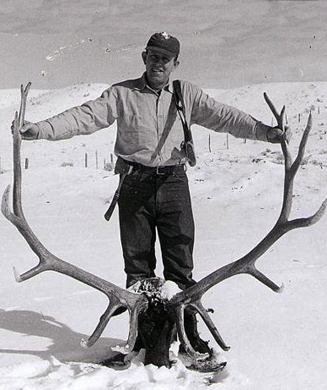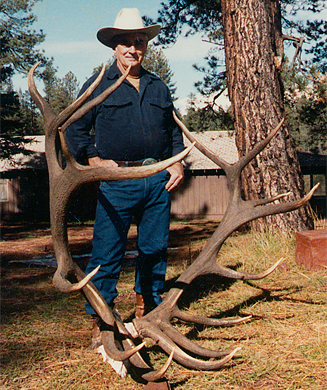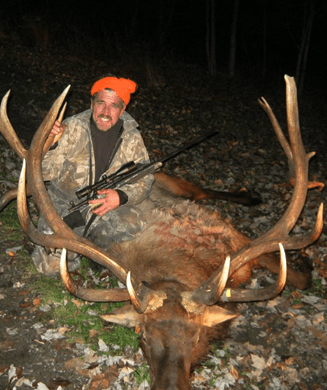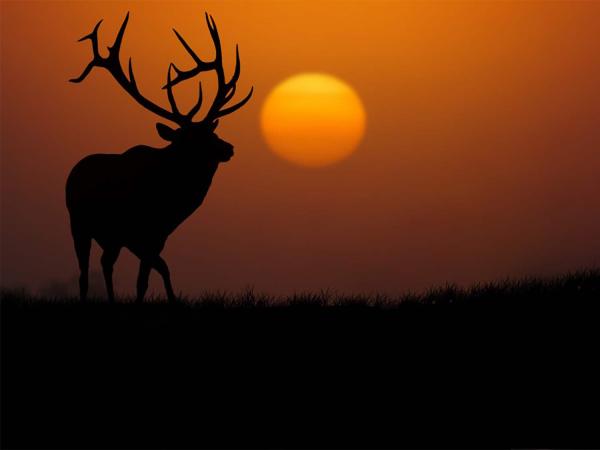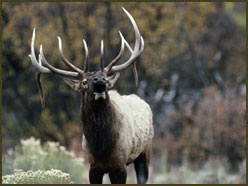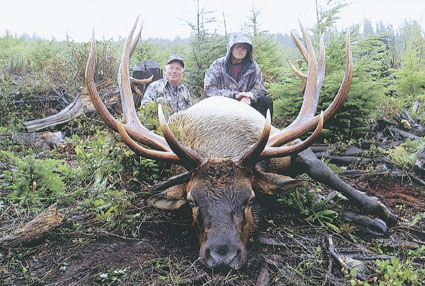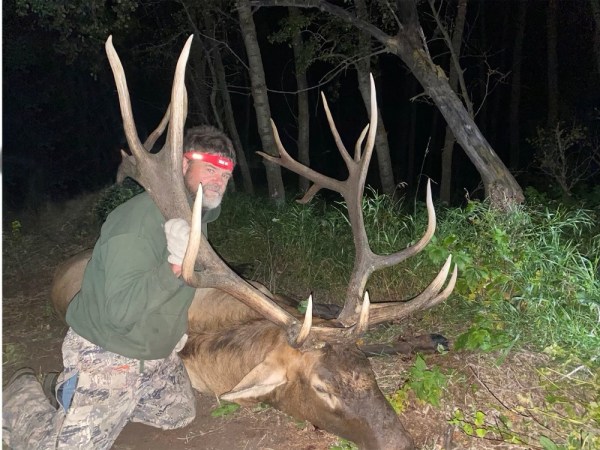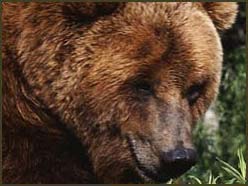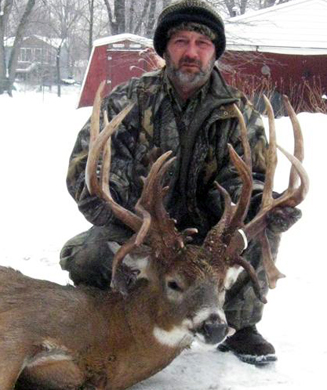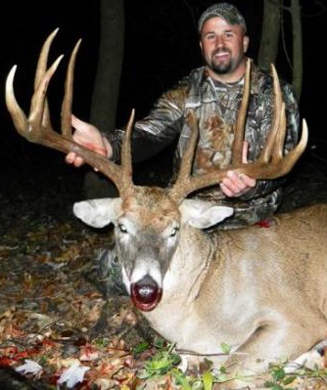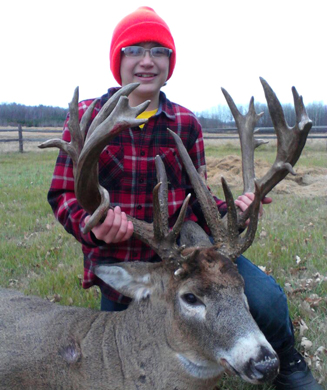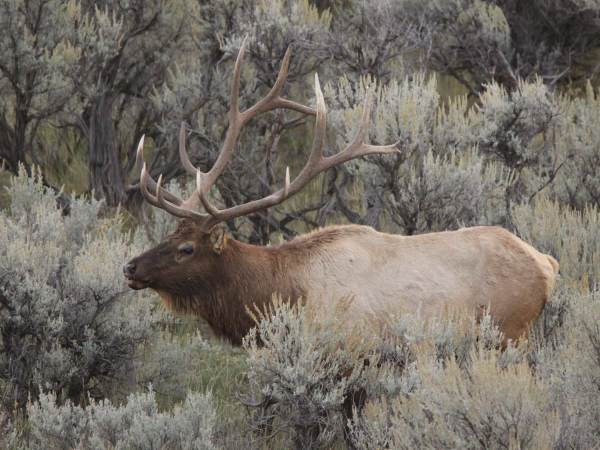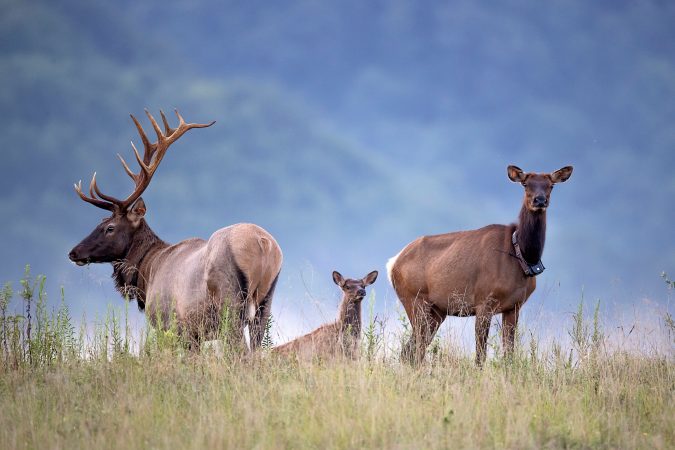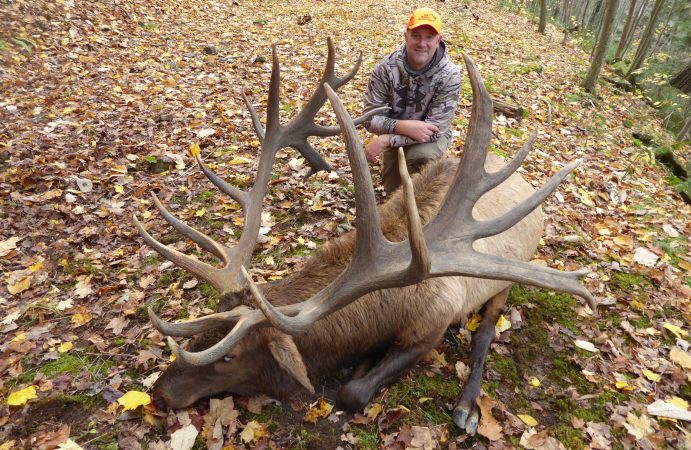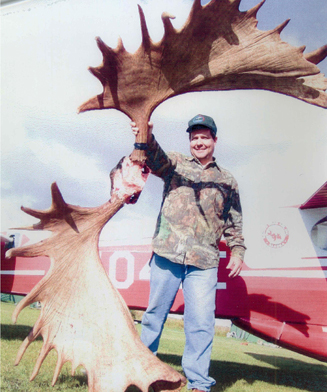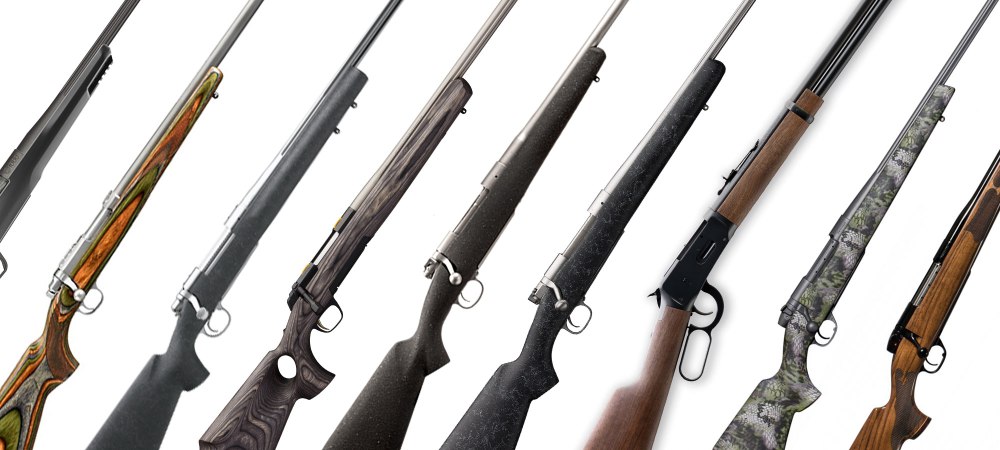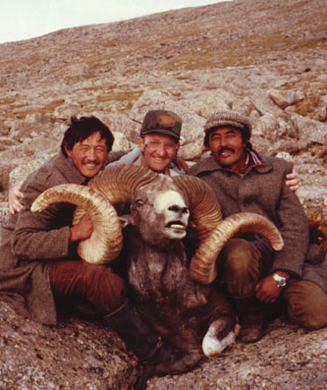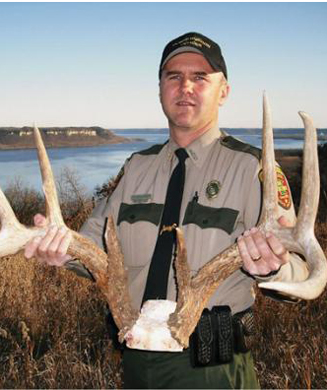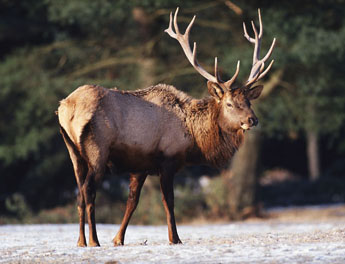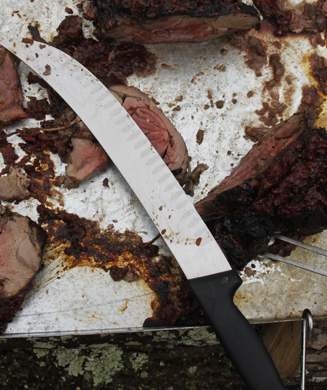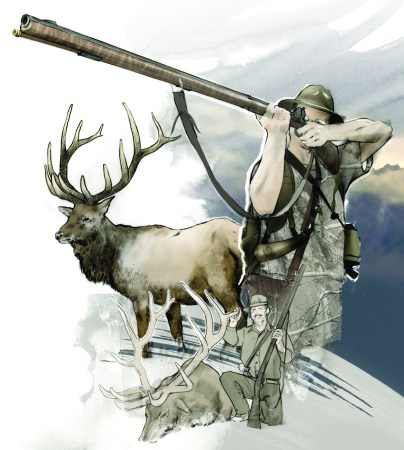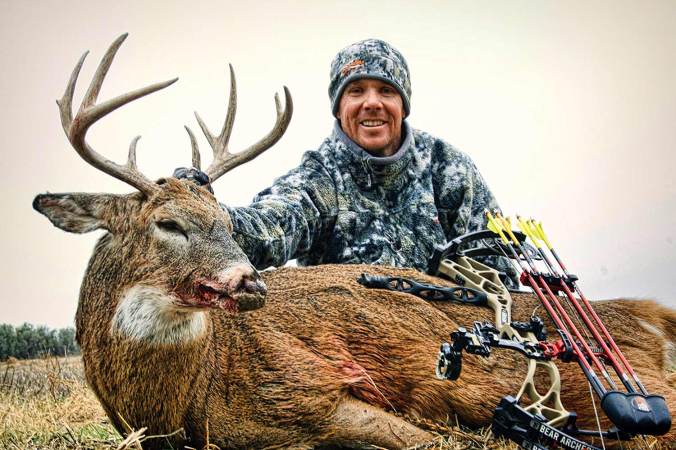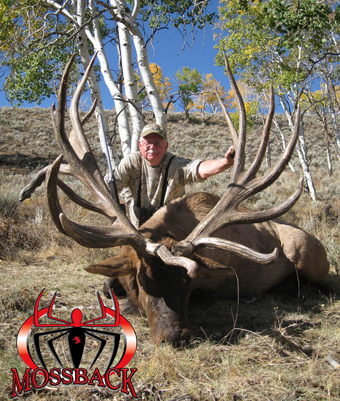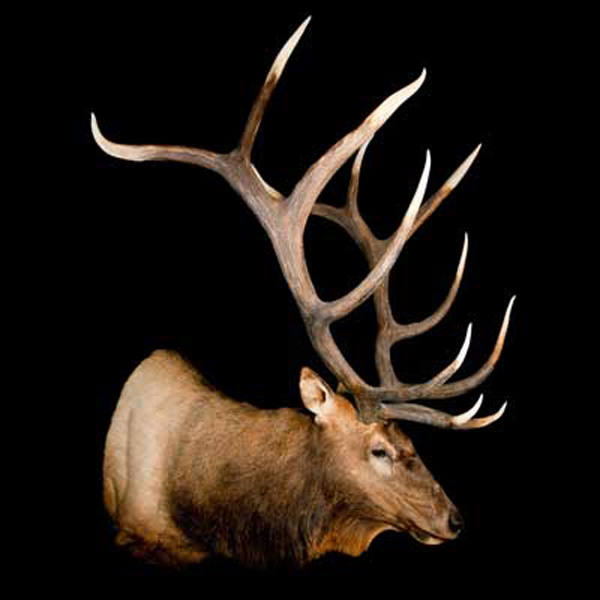
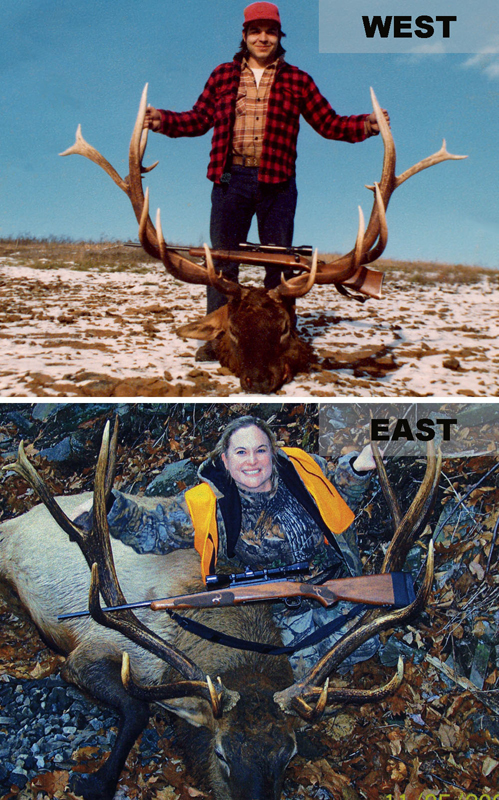
West: 433 1/8 Latah County, ID
Hunter: Peter J. Orazi, Jr. 1977
Overall Rank: 14 East: 395 1/8 Cameron County, PA
Hunter: Lisa R. Banasick (2009)
Overall Rank: 181 Idaho's state record was taken back in 1977. And the state has been hard-pressed to get a bull of its caliber ever-since. Wolves and subdivisions there are working against creating big behemoth bulls, but so is the environment. In just looking at the two photos, one can surmise Pennsylvania bulls are woodland dwellers with dark, amber racks more reminiscent of a Roosevelt's elk than its Idaho cousin. A bull in an open pasture or field in Idaho has a pick-up truck full of over-the-tag hunters aiming for him. In Pennsylvania, lottery draws and tightly regulated hunting have proven effective in making big bulls. Poaching there has certainly taken its share of big bulls, but keep reading to find out why you'll be seeing much more of Pennsylvania.
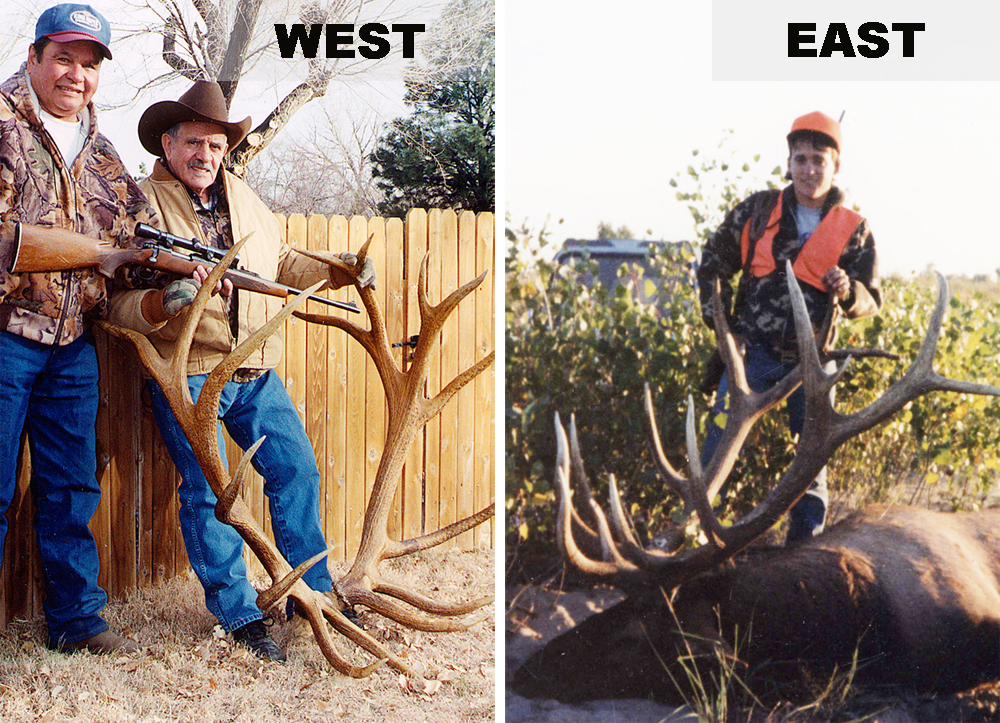
West: 434 3/8 Colfax County, NM
Hunter: Lawrence Sanchez 1962
Overall Rank: 13 East: 398 4/8 Morton County, KS
Hunter: Camron Paxton (1987)
Overall Rank: 153 Will Kansas be touted as the next hotbed for elk hunting? Not likely, but this bull is second in the state only to a 400-class monster. Much elk hunting in Kansas takes place on Fort Riley military base, but success rates there are relatively low in recent years. Elk also roam the Cimarron National Grasslands, where hunting is illegal, but not so on the surrounding private lands. And because of over-the-counter permits and landowners always on the lookout for a big elk, few make it long enough for big headgear. New Mexico still offers up healthy bulls but they aren't everywhere. Though I'll bet my beer money the odds are better there than Kansas. Best the Jayhawks stick to basketball.
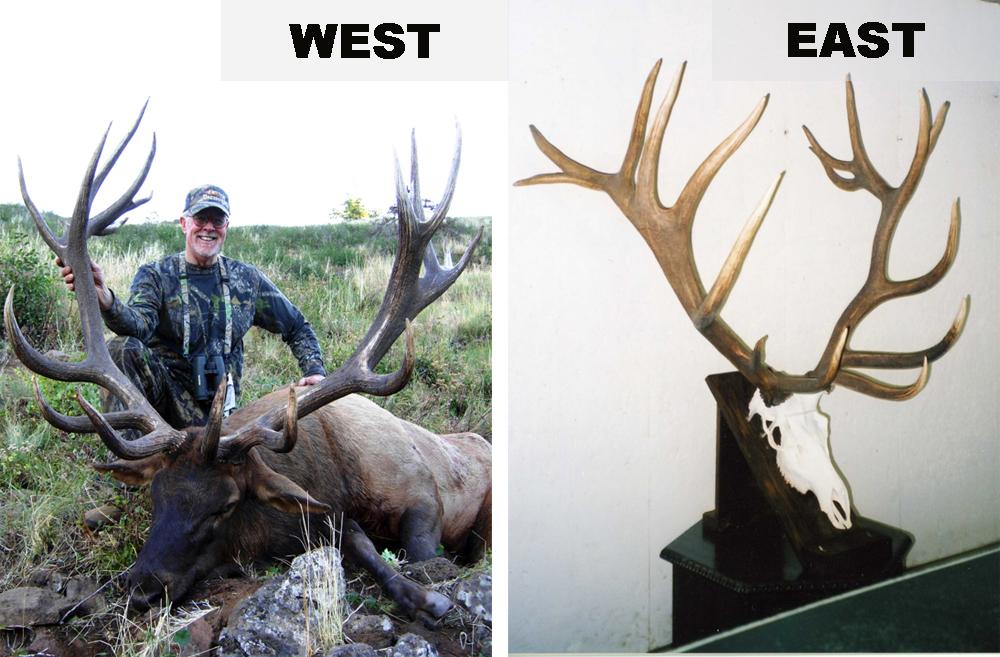
West: 436 4/8 Columbia County, WA
Hunter: Dan J. Agnew 2008
Overall Rank:12 East: 400 2/8 Elk Co., PA
Hunter: Barry L. Klusewitz (2005)
Overall Rank:142 Rumors and conjecture on how this Washington bull was killed followed Dan Agnew around like a swarm of black flies on an elk's ass in July. We won't get into the details here, but a simple Google search will do wonders for your curiosity. Technically, his elk is a Rocky Mountain Elk and a Washington state record. Agnew shot it on Washington's east side, even though with those heavy beams and dark, dark antlers it looks alot like a Roosevelt's from the western side of the Cascade Range. Oddly enough, this Pennsylvania bull looks more like a Rocky Mountain Elk than Agnew's. What gives? This bull or some Roosevelt's genes could have found their way into a herd in Washington's Columbia River country. It's certainly not impossible. But all that crowning is a real head scratcher. And that Pennsylvania bull? It certainly looks like it may have been better off scored as a typical.
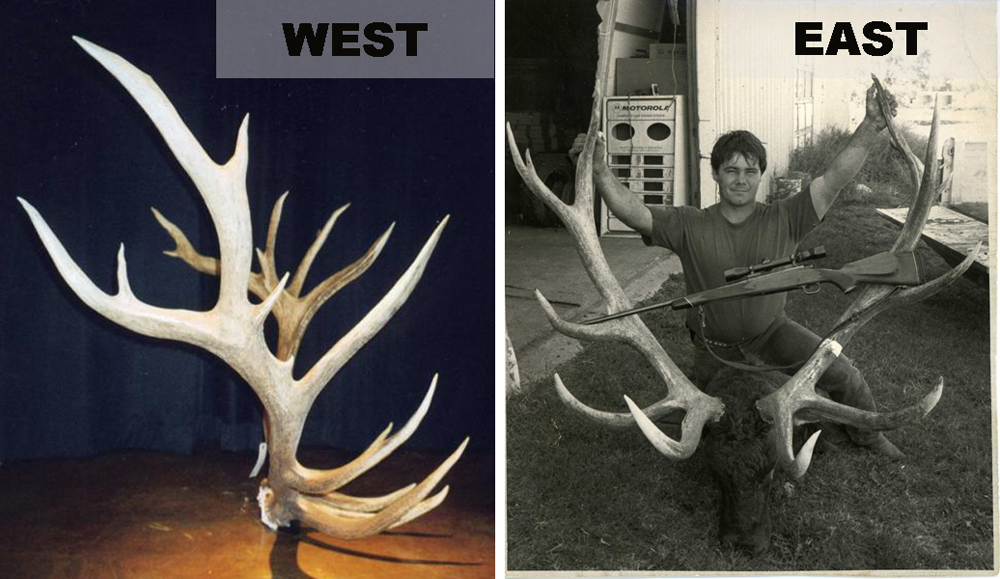
West: 439 5/8 Laramie Co., WY
Hunter: Joseph C. Dereemer (1971)
Overall Rank: 11 East: 402 1/8 Morton Co., KS
Hunter: Jeff A. Newton (1988)
Overall Rank: 122 It's Kansas yet again now up against the Wyoming powerhouse. Much of Morton County where Newton killed this Kansas bull belongs to the Cimarron National Grasslands, which now have about 50 elk. You can bet a bull like this stood out like a hippy at a Rick Santorum rally, and both wouldn't last long. Wyoming is still sporadically producing solid 400-class bulls here and there, though few come close to this beast.
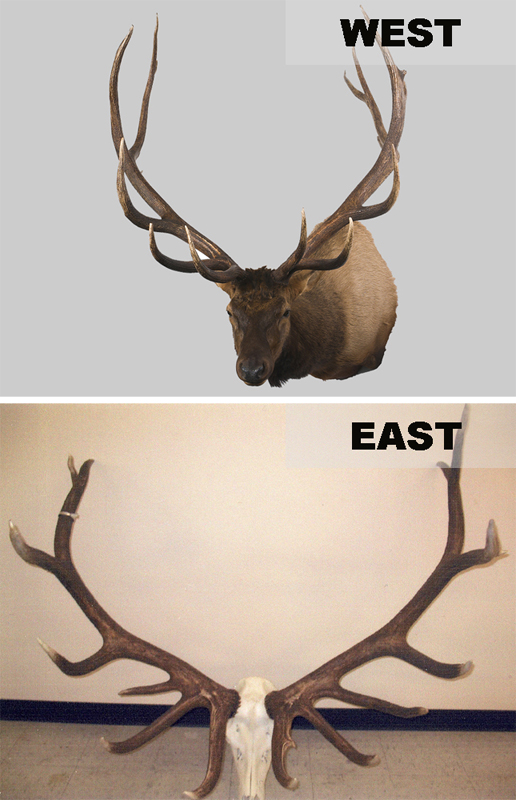
West: 442 3/8 Gila Co., AZ
Hunter: Dan J. Agnew (2001)
Overall Rank: 9 East: 409 7/8 Garden Co., NE
Hunter: Dana L. Foster (2008)
Overall Rank: 62 No, this isn't a typo. Agnew is back but this time with his Arizona bull. Both of these bulls are fine specimens, but if you go on records alone, it seems these bulls are lurking behind every corral in Arizona. (Note: the next three bulls are from Arizona). Not so for Nebraska. To be honest, I'm not sure about the how's and why's behind this bull. Much of Nebraska's elk country is north of where this bull was taken. Nebraska has a strong 2,300 head of elk, but that pales in comparison to Arizona's average of around 30,000. Just this past September, another 400-class bull was killed in the Hat Creek Unit in Nebraska. While it's good to see elk cruising Nebraska, they have their work cut out for them if they are to compete with the big boys.
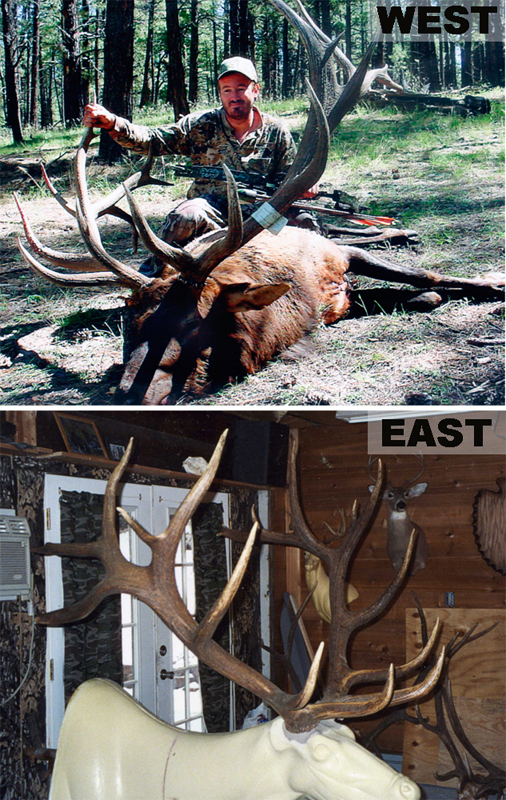
West: 444 4/8 Coconino Co., AZ
Hunter: Ronald N. Franklin (2003)
Overall Rank: 8 East: 423 6/8 Clearfield Co., PA
Hunter: Reed L. Bamberger (2009)
Overall Rank: 20 These two bulls are part of the elk match-up of the century. Arizona has long been a producer of very big bulls, but those bulls come with a very steep price tag as most of them are shot on one of two Native American reservations. A guaranteed hunt there will cost you a new pick-up. Pennsylvania though will cost a nonresident $351. The catch? You have to draw a tag. The odds are slightly better than Powerball. But believe it or not, those bulls being killed in Arizona are most certainly related to the very same bulls killed in Pennsylvania. In 1913, elk were trapped from Yellowstone National Park and relocated to both these states. That's right. We're talking same bloodlines, which may help to explain the next couple of slides. Arizona was home to an extinct species of elk called Merriam's. Then in the early 1900s, a local elk lodge helped one insightful fellow pay $1,265 to have 80 trapped and shipped from Yellowstone National Park. Numerous other shipments from the Park helped boost numbers. Insightful management and rough country helped boost record-book entries. As for Pennsylvania, 145 elk were shipped there between 1913 and 1926. They struggled mainly because they taste so good, and their numbers stagnated until the late 1990s when interest in Pennsylvania elk and the elk living in Elk County peaked. Now, the state is home to 750 elk, but their state record for non-typical bulls gets broken on a regular basis. Keep going to find out why they produce such beastly bulls. We're not calling this one yet.
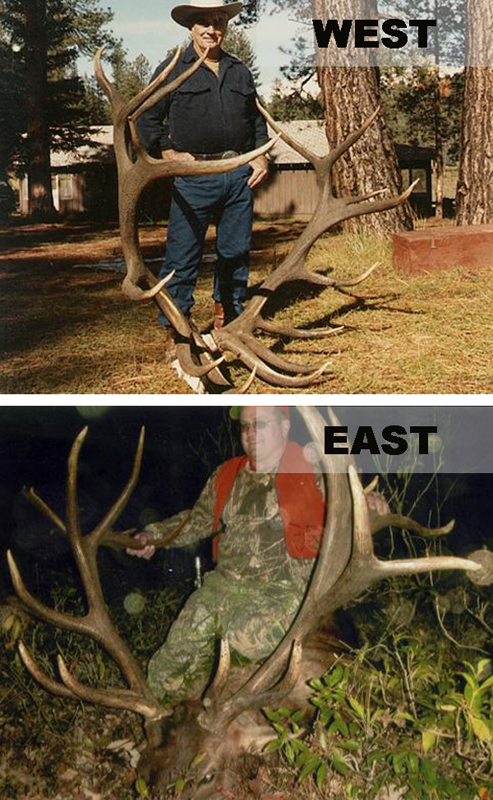
West: 445 5/8 Apache Co., AZ
Hunter: Jerry J. Davis (1984)
Overall Rank: 7 East: 441 6/8 Clinton Co., PA
Hunter: John A. Shirk (2006)
Overall Rank:10 These bulls are just so close it hurts. But you'll see a trend if you look at the dates. Entries for big Arizona bulls are moving further away from the present day, while Pennsylvania bulls are getting bigger and bigger every year. There are some very rural parts of Pennsylvania, but not compared with the most rural portions of Arizona. All those Philly fans means many more encounters with elk and elk usually lose. Nowadays, more hunter buy-in for a very popular elk hunt means more advocates for elk habitat, which produces bigger elk. And that is exactly what Pennsylvania has seen. Keep going to see the state's likely new record and our take on why the state just might produce the next world record elk.
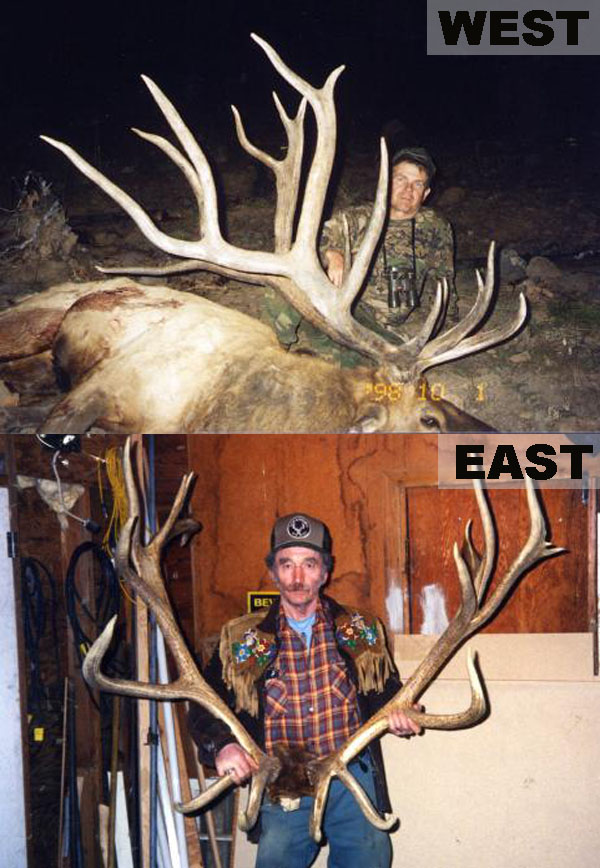
West: 450 6/8 Apache Co., AZ
Hunter: Alan D. Hamberlin (1998)
Overall Rank: 4 East: 447 1/8 Gilbert Plains, MB
Hunters: James R. Berry D.J. Hollinger & B. Howard (1961)
Overall Rank: 6 Stop thinking about Quaker country a minute and head north to Manitoba. Yes, Manitoba has elk, and back in the day, they had some big ones. These days, though, elk over 400 inches are tough to come by. Not the case for northeastern Arizona. Apache County is a skinny county that borders New Mexico, but in that county live some of the biggest Rocky Mountain Elk on earth. It is home to the White Mountain Apache Reservation where tightly regulated hunting and careful management consistently produce record-book bulls. Want to kill a record bull? Then this is the place, though you'd better put off sending your kid to college because you're going to need that tuition money to pay for your hunt.
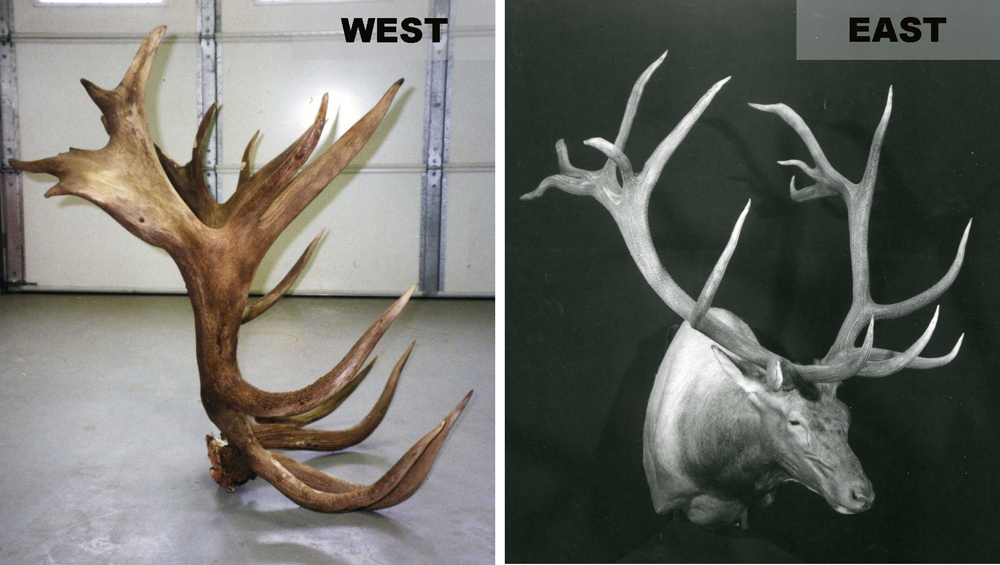
West: 465 2/8 Upper Arrow Lake, BC
Hunter: Picked Up (1994)
Overall Rank: 2 East: 449 7/8 Golden Valley Co., ND
Hunter: Kevin D. Fugere (1997)
Overall Rank: 5 A couple of unlikely candidates duke it out for the second spot. British Columbia is rugged, and still rugged enough for bulls to die of old age or drowning, which likely is how this bull died. North Dakota may not be quite the backcountry of British Columbia, but there are certainly some hidey holes there. I am continually surprised with the bulls that come out of North Dakota. I put them in the "east" category simply because the Rockies don't run through them and you have to draw the line somewhere, right? Most of their bulls, though, are coming from counties that border the line with Montana or Theodore Roosevelt National Park. This is certainly a big bull, but the state's real strength is in the typical bulls category. Even so, I think the hills of BC have some fine bulls, but we'll never see them.
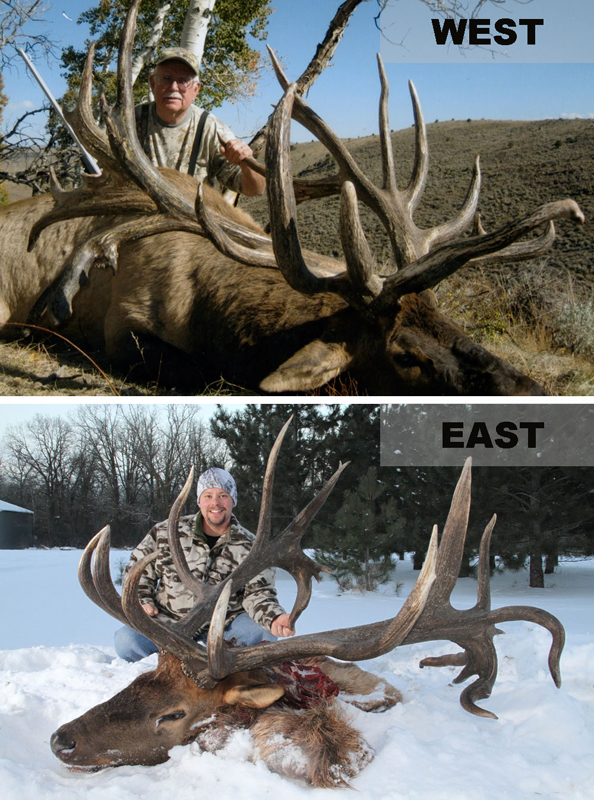
West: 478 5/8 Piute Co., UT
Hunter: Denny Austad (2008)
Overall Rank: 1 East: 458 4/8 Kittson Co., MN
Hunter: Picked Up Ryan L. Muirhead (2010)
Overall Rank: 3 The story of this Minnesota bull is just about as odd as Minnesota having the all-time number three bull. The state has less than 200 elk total but private land and only a dozen elk tags have helped create this absolute hog. Sadly, its giant rack was his demise. He didn't clear a barbed-wire fence, tripped and landed with his antlers stuck and eventually frozen in the mud. Some hunters freed him, but he caught pneumonia and died soon after. And for Utah, this is the infamous Spider Bull. Legend has it that this thing had so many guides staked out on him that the bull sent them all Christmas cards before being shot by Denny Austad who purchased a Governor's tag, hired an "outfitter" to put him on this very bull, and you know how it ends. It was investigated and considered fair chase by Boone and Crockett standards. Utah has far better odds at churning out big bulls.
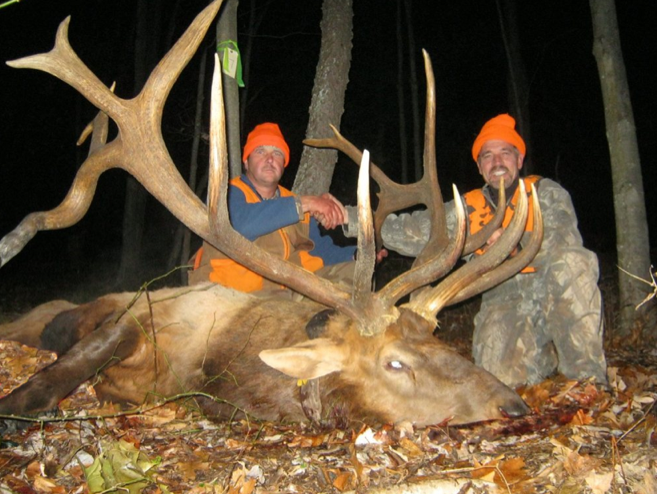
This bull is still pending a full review, but all signs point to this as the new Pennsylvania state record. Why so big? When was the last time Pennsylvania had a week straight of below zero weather in spring, during calving time? Seen any wolves there lately? No and no. Plus, western elk don't have near the amount of available forage that Pennsylvania bulls do, says Tom Toman, Director of Conservation Programs at the Rocky Mountain Elk Foundation. Antler growth is surplus energy, he says. In the spring, elk eat to refurbish the body first, then everything else goes into making big antlers. When you spend less time trying to stay warm and fending off predators, you're going to put that energy into making bigger antlers. If you think about it, elk have an all-you-can eat buffet year-round in Pennsylvania. They can eat all the time. Don't even get me started on mast crops. And those elk out West? They work the snowlines eating green shoots, all the while keeping a wary eye on predators following them around. For these reasons, if a Pennsylvania bull can get more than six years old without becoming a decoration, it will likely put the Spider Bull out of the top spot for biggest non-typical.
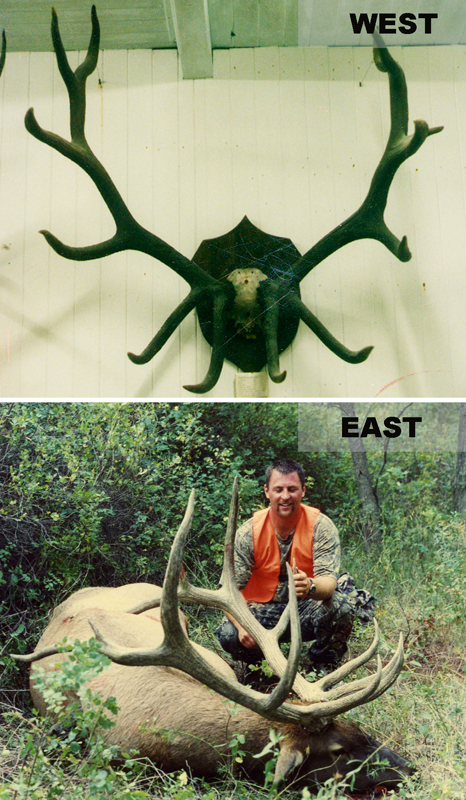
West: 418 7/8 WY
Hunter: J.G. Millais 1886
Overall Rank: 10 East: 375 5/8 Billings Co., ND
Hunter: Monte Hoggarth (2000)
Overall Rank: 662 Typical antlers are the way nature intended them to be. At least that's what Justin Spring, Boone and Crockett's Assistant Director of Big Game Records says. Asymmetrical antlers are nature's way of saying that something has gone or is wrong. Biological symmetry is everywhere in nature, why not have it in antlers. He claims that elk are the most inbred species we have. As an elk guy myself, that stings a little, but think about it. Nearly all of the elk we see and love today came from a brood stock of roughly 25,000 elk living in Yellowstone National Park. That was back in 1891. Elk had been nearly wiped out everywhere else, but they were protected in Yellowstone. And what you get is a family tree that has relatively few branches. And now that brings us to typical antlers, with their sleek lines, pleasing symmetry and arguably less familial baggage than their non-typical counterparts. Granted, none of these bulls will approach 500-class, but then again, maybe they're simply a better representation of the species.
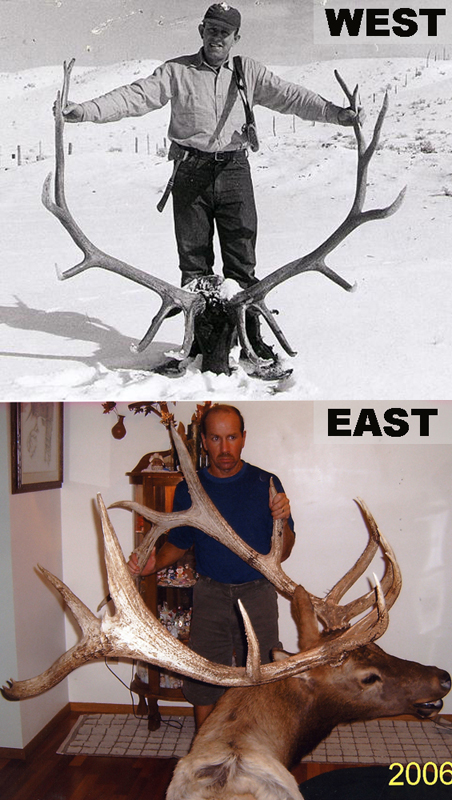
West: 419 4/8 Madison Co., MT
Hunter: Fred C. Mercer (1958)
Overall Rank: 9 East: 376 4/8 Golden Valley Co., ND
Hunter: Barry L. Tescher (2004)
Overall Rank: 617 As you can tell by the old photo, Fred Mercer took this bull back when men were men and they used a hatchet for everything from gutting an elk to shaving. And Mercer's 54-year-old record still stands today as Montana's biggest ever typical elk. And as you keep flipping slides to get to the number one typical bull match-up, you'll find North Dakota bulls coming from Golden Valley, North Dakota, which is really the only place to hunt for big bulls in the state. Barry Tescher took his bull there back in 2004. Keep reading to see why this open country of North Dakota produces such lovely specimen.
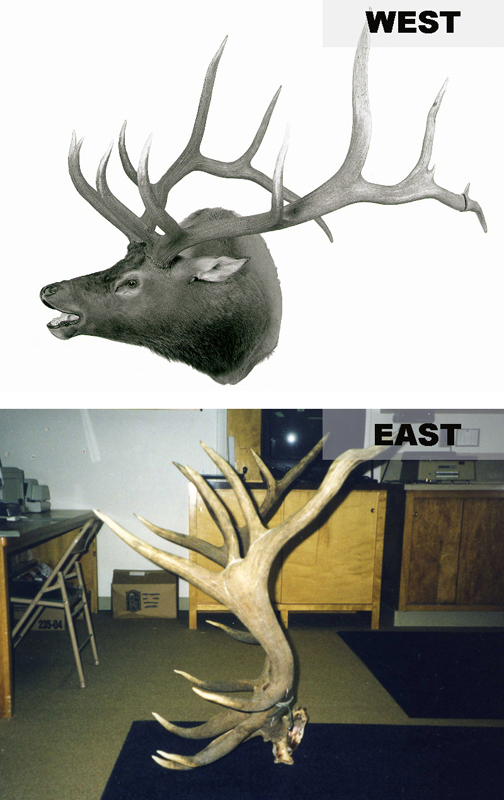
West: 419 5/8 Panther River, AB
Hunter: Clarence Brown (1977)
Overall Rank: 8 East: 377 Dawes Co., NE
Hunter: John Walker (1998)
Overall Rank: 584 This state and this province have produced similar bulls, the only difference being Alberta may be past its prime. But, if you decide to go, be sure to check the Panther River area. Though the area hasn't produced big record-book bulls since this bull from 1977, it's worth a look. Nebraska on the other hand seems to be coming into its own. As long as landowners are willing to supplement a few big bruisers, then the genes are there, the wide open space is there, and with relatively few predators on four legs, I predict more record typicals coming out of here.
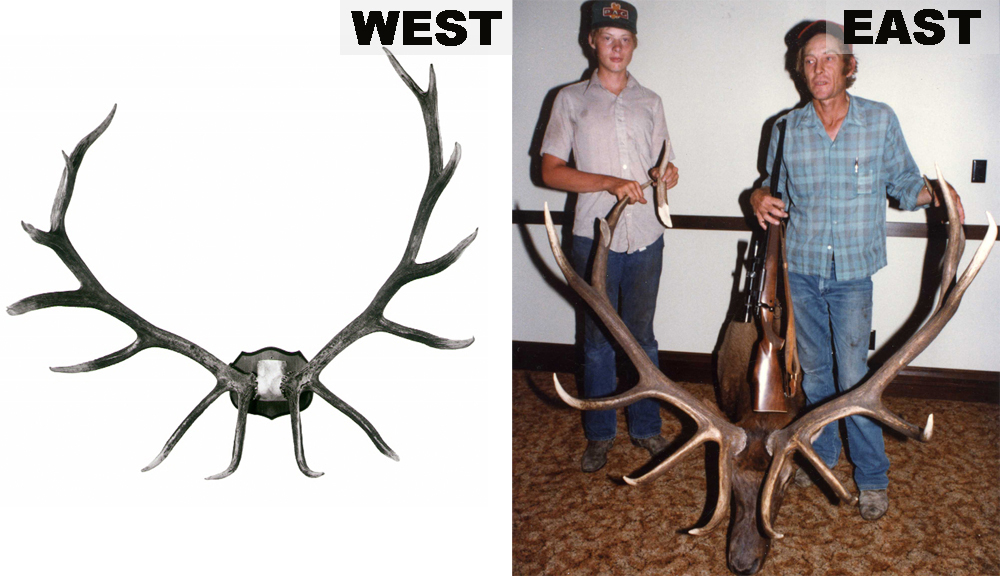
West: 420 4/8 Yakima Co., WA
Hunter: Charles F. Gunnier (1990)
Overall Rank: 7 East: 377 3/8 Lawrence Co., SD
Hunter: Larry Miller 1980
Overall Rank: 572 Remember how I was saying North Dakota is the state to go for big typicals? Well, this is the stick in my bike spokes. South Dakota is only open to residents and it's the Black Hills that they're hunting. Managers are trying to get a handle on elk populations there and grow them by limiting hunting opportunities for the coming seasons. There are plenty of places for big bulls to hide in the Hills, and I think we haven't seen the last of the big boys. I just don't think they will get near as big as the typicals that usually come from North Dakota. Washington's Gunnier bull was taken on the Yakima Indian Reservation, and it is a bit of an anomaly for the state. Most hunters head to the Blue Mountains of southeast Washington where elk and hunter densities are high. I don't really see a big typical coming out of the Blues. But, and it's a big but, Washington has a number of solid roadless areas, some of which abut the Reservation where I have no doubt big bulls hide successfully.
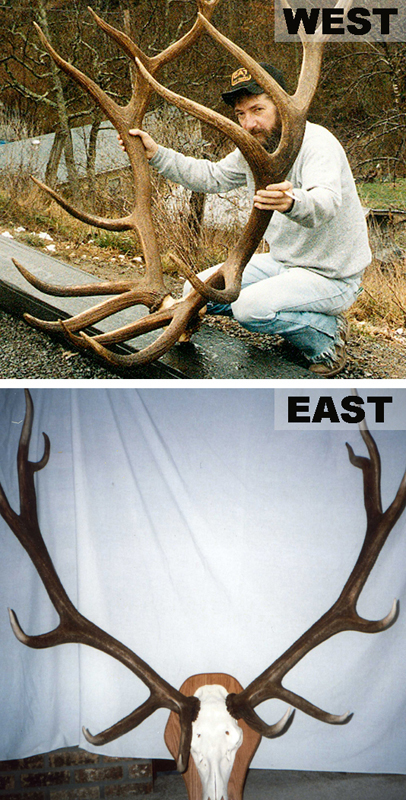
West: 421 4/8 Gila Co., AZ
Hunter: James C. Littleton (1985)
Overall Rank: 6 East: 378 Golden Valley Co., ND
Hunter: Dwight Ormiston (2005)
Overall Rank: 545 Well looky what we have here. Instead of Arizona going up against Pennsylvania, it's North Dakota. But the spread here is a good 50 inches. I will say North Dakota has supplied 370-plus bulls consistently. And Arizona supplies 400-plus bulls every year for the record books. Littleton killed his bull on the San Carlos Apache Reservation. To grow big bulls on the San Carlos, managers keep hunter densities low, weed out the "ugly" bulls through management hunts and keep the best of the best. So why don't typical bulls grow like this in places like Pennsylvania? Why do those lovely symmetrical antlers grace Arizona and North Dakota bulls? Justin Spring of the Boone and Crockett Club has a theory on that too. He looks at game breeding programs for whitetails. Deer that live in close proximity to each other and who don't mix up their genes once in awhile will have massively non-typical (deformed) antlers. Pennsylvania bulls have very little immigration or migration of their genes, and they don't have the open landscapes like those seen in the West. We'll see this match-up again, so I'll wait on the winner.
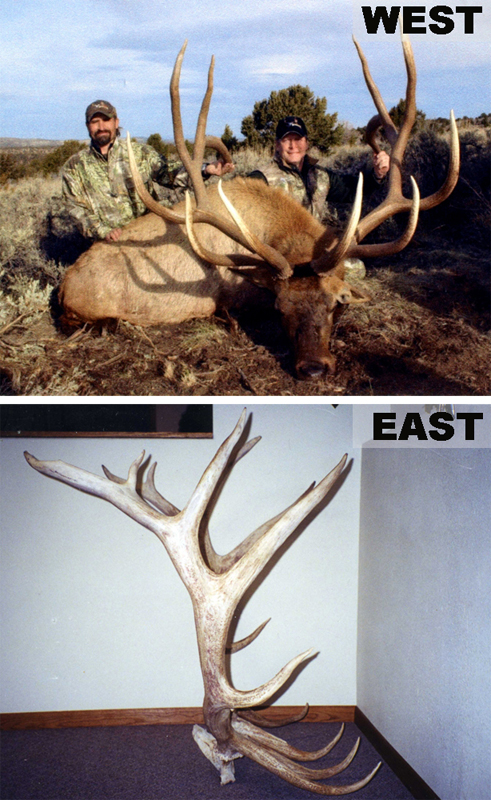
West: 422 5/8 Grand Co., UT
Hunter: Ron F. Skoronski (2006)
Overall Rank: 5 East: 385 6/8 Billings Co., ND
Hunter: James A. Feser (1998)
Overall Rank: 252 Another western "go-to" state, Utah, produced the world record non-typical and this, the number 5 overall typical is the biggest typical to come out of there yet. I seriously doubt if it will be the last. The state has around 73,000 elk and managers there are liberal with cow tags and spike permits stacking the deck for older age class bulls. Nonresidents looking to draw one of the coveted limited-entry tags are going to deal with 1:44 odds. But man, if you draw one of those, the sky is the limit. Just be sure to get off the main roads and out of your truck. You won't be the only one looking for a bruiser in the state. But if you get far enough into a roadless area, chances are you'll beat the state record. More on North Dakota in a minute. Without a doubt, the West wins this one.
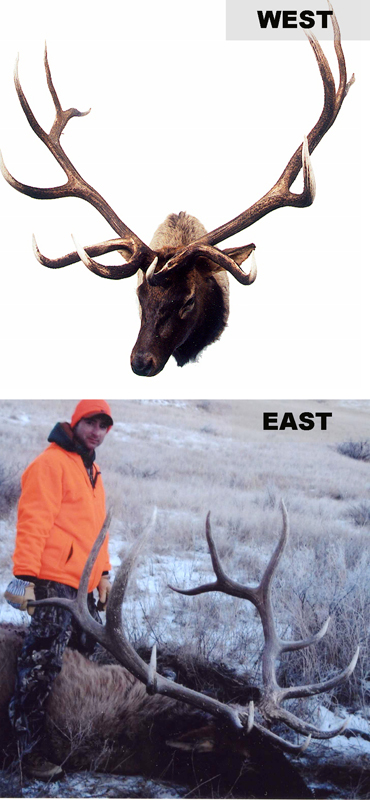
West: 425 3/8 Nye Co., NV
Hunter: Jerry McKoen (1999)
Overall Rank: 4 East: 389 3/8 Billings Co., ND
Hunter: Terry J. Doll (2007)
Overall Rank: 171 You can certainly see a trend here with the North Dakota bulls. They are all going to be found against the Montana line and most likely near Theodore Roosevelt National Park. This bull is the most recent big boy to come out of the state. But sadly, if you don't live there, you're only chance to win this one is with one raffle tag. Not so for Nevada as they are open to nonresidents, but if you draw, you're looking at over a $1,000 just for the tag. Aside from this bull, there is only one other 400-class typical in the record books, and it barely made it to 400. All things considered, I'd still have to say advantage West.
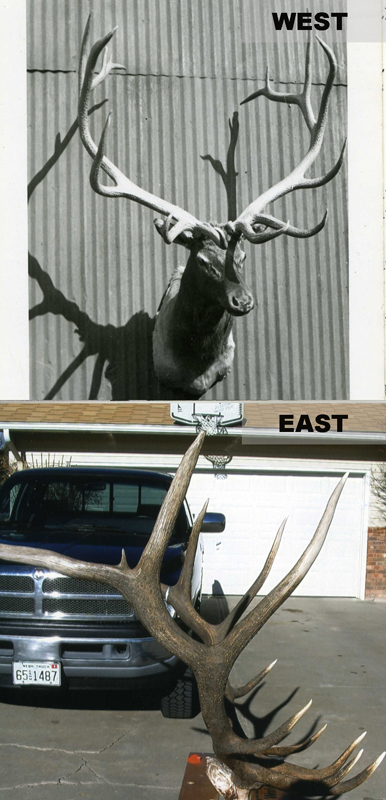
West: 441 6/8 Big Horn Mts., WY
Hunter: Unknown J (1890)
Overall Rank: 3 East: 390 3/8 Sioux Co., NE
Hunter: Robert L. Marsteller (2004)
Overall Rank: 151 This bull was killed the same year Wyoming joined the Union. And sadly, that may be the last typical record-book top 10 elk we see out of that state. It's just not happening there anymore. They have plenty of elk, but many hunters are out there bagging bulls that could be this big if left alone. Those older-age class bulls just aren't happening. But in Nebraska, as I've said before, they could make it happen. But again, folks have to let the bulls get big. And it's hard. Would you pass up a 400-inch typical bull, hoping that next year he'll be even bigger? I didn't think so. I think this one is a draw.
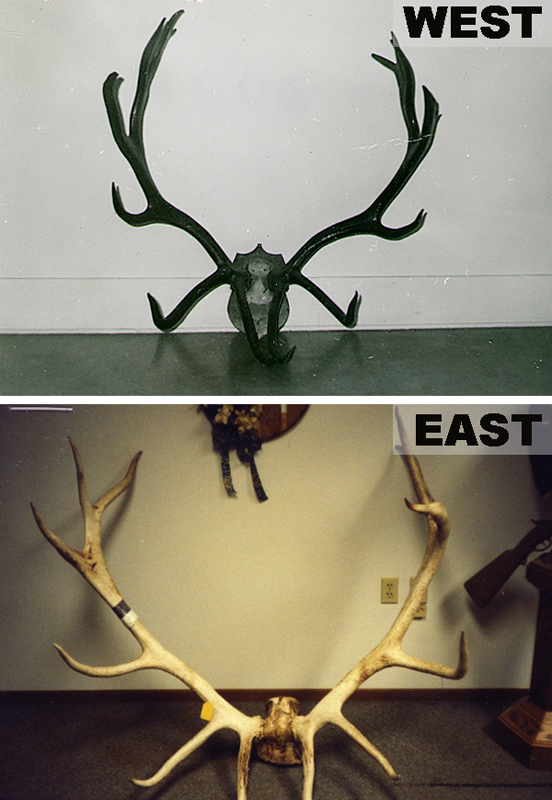
West: 442 3/8 Dark Canyon, CO
Hunter: John Plute (1899)
Overall Rank: 2 East: 396 Billings Co., ND
Hunter: Paige M. Burian (1997)
Overall Rank: 82 Rocky Mountain Elk high? I get that every September, but luckily I get to hunt elk in Montana for $20. For everyone else looking to hunt over-the-counter elk without skipping a mortgage payment, Colorado is your place to go–just don't count on seeing any typcials over 400. One hunter killed one in 2007 that was 4/8 over 400. But let's be reasonable. The hills are going to be smothered in orange unless you get way on back in the backcountry. Then, you'll compete with fewer foot soldiers and more cavalry. It's a grudge match out there. But at least you'll get a shot, right? North Dakota, as you've learned, won't even let you hunt them. Based on that alone, I'll split this one.
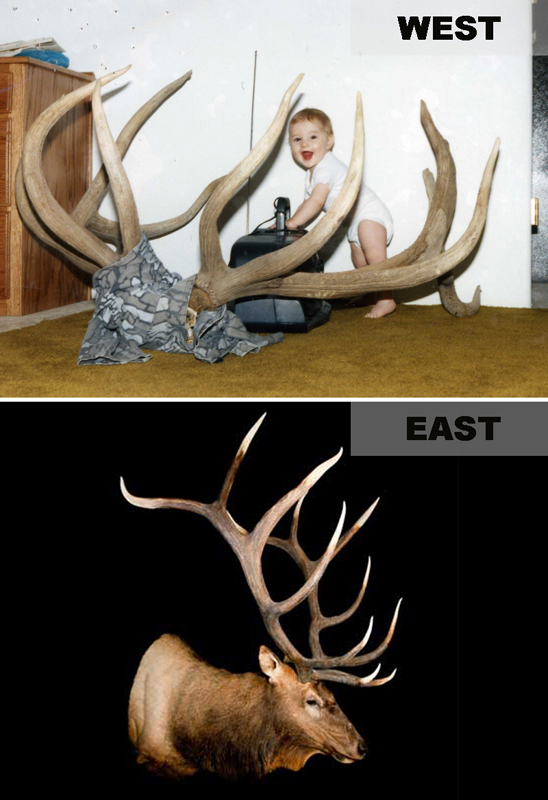
West: 442 5/8 White Mts., AZ
Hunter: Alonzo Winters (1968)
Overall Rank: 1 East: 403 Billings Co., ND
Hunter: Dan Jahnke (1997)
Overall Rank: 35 We'll end on a familiar match-up. It's been a very long time since Arizona has produced a typical bull like Winters' bull from 1968. But if you look at the numbers and compare them to North Dakota's (East's) number one bull, 40 inches is a long way to go if you're an antler. Arizona has 12 record-book bulls that are bigger than this North Dakota record. I'm not trying to take anything away from North Dakota. That's a fine bull by anyone's standards. I'm just calling it like it is. In the end, I have to give this one to Arizona.
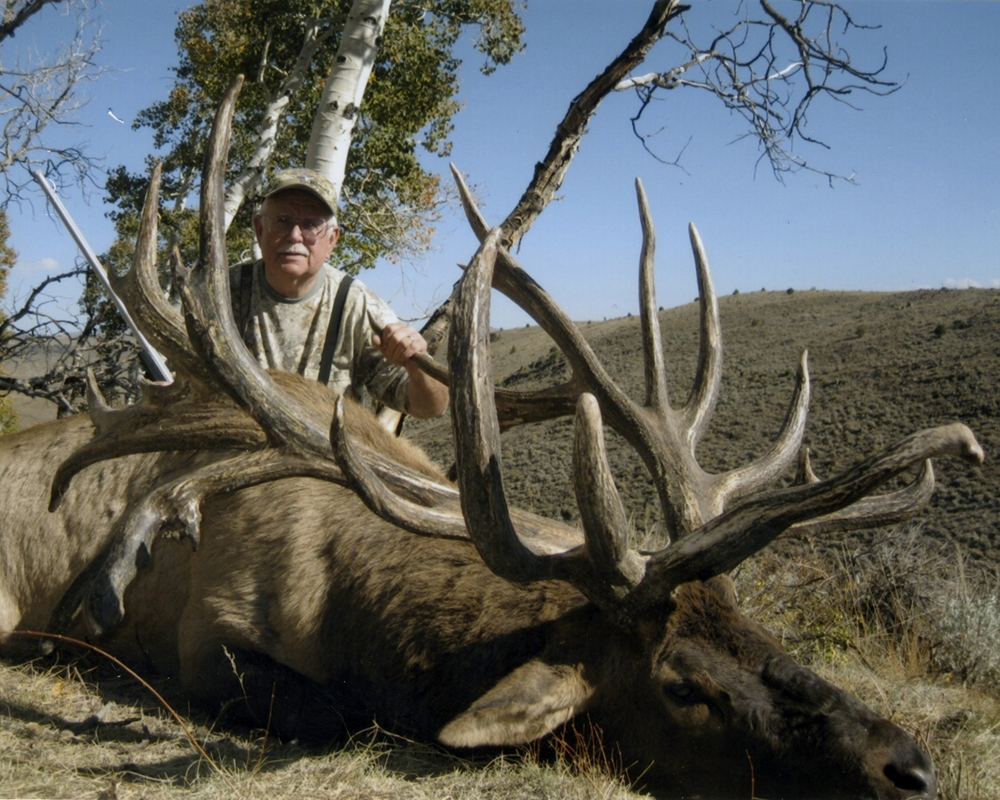
Our oldest bull in this line-up is more than 125-years-old. A lot has changed for elk and hunting in those years. Since a low of less than 30,000-head in the early 1900s, elk numbers have rebounded to a current population of more than a million. By and large, the West has had more and bigger record-book bulls than the East. But the times are changing. In the past 15 years, North Dakota has produced seven of the top 10 Eastside bulls. Of all the elk on this list, 10 Eastern bulls were entered in the last 10 years while Western entries were half that in the same time period. Then again, we may be comparing apples to oranges here. Consider that in the same 15-year period mentioned above, Arizona has had nine typical elk score bigger than North Dakota's state record. The Eastside certainly has its work cut out for them if they expect to give chase for the typicals category. But it's a closer race for nontypicals. It seems Pennsylvania is breaking its own state record every year, and the state will soon claim half of the Top Ten nontypical spots for eastern elk. Their new state record is roughly 40 inches away from the world's record, which is a lot, but considering all of Pennsylvania's Top 10 entries were taken after 2005, I think they stand a solid chance at breaking the nontypical record. The habitat is there and the predators are not. The climate is favorable and good genes run through the herd. But are elk on the East Coast really all that wild? I'll bet you can get pretty lost on reclaimed coal mine land there, but the boundaries for official "elk country" are very clearly defined. Many of the big bulls are well known and have names. Then again, is hunting eastern elk easier than being led straight to one particular record-book Utah bull that you've already seen video and photos of? Maybe you even have its sheds in your garage thanks to the outfitter? The beautiful thing about elk hunting is that it can be as wild and difficult or as tame and easy as you want it to be. Different strokes for different folks. For me? I'll be looking for a nice fat cow to fill the freezer. I love big antlers, but no matter how long you let them hang, they never taste that good. For more monster elk…
Top 40 Typical and Nontypical Elk Ever Taken
Each year more and more trophy bulls are tagged east of the Rockies. We put the top 20 bulls in the East up against the 20 biggest bulls in the West. See the photos!
